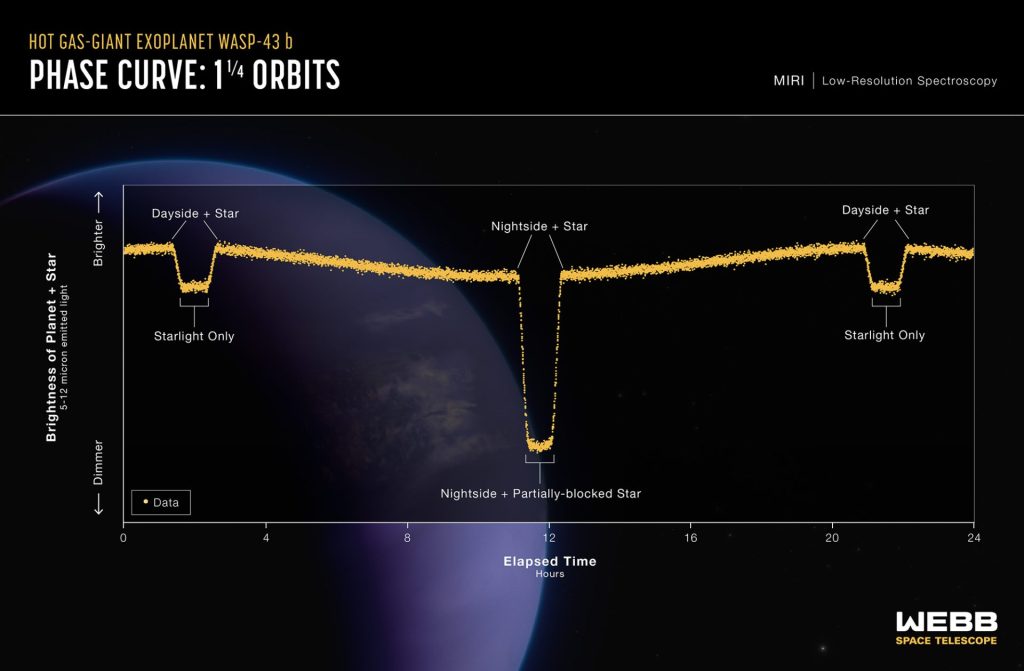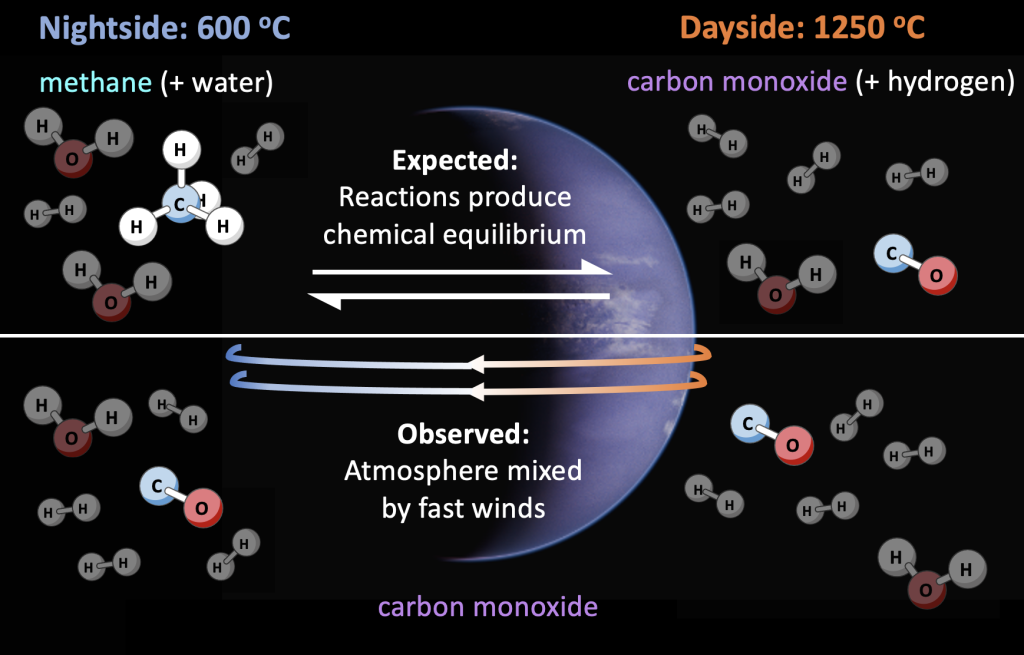An international team of researchers, including members from CEA, utilized NASA’s James Webb Space Telescope to map the weather of the hot gas giant WASP-43 b.
Measurements in mid-infrared obtained with the MIRI instrument, combined with 3D climate models and other observations, suggest the presence of thick and dense clouds on the night side, clear skies on the day side, and equatorial winds reaching up to 8,000 km/h, mixing atmospheric gases around the planet.
This study showcases advancements in exoplanet science enabled by the unique capabilities of JWST to measure temperature variations and detect atmospheric gases hundreds of light-years away.
This study is published in the prestigious journal Nature Astronomy.
Hot Jupiter tidally locked
WASP-43 b is a “hot Jupiter” exoplanet (Figure 1). Similar in size to Jupiter and primarily composed of hydrogen and helium, it is much hotter than the gas giants in our own solar system due to its proximity to its star, at less than 1/25th of the distance between Mercury and the Sun.
With such a tight orbit, the planet is gravitationally tidally locked, always presenting the same face to its star. Thus, it has one side continuously illuminated and the other perpetually in darkness. However, even though the night side never receives direct radiation from the star, eastward-directed atmospheric winds transport heat from the day side.
Since its discovery in 2011, WASP-43 b has been observed with numerous telescopes, including NASA’s Hubble and the now-retired Spitzer Space Telescopes.
“With Hubble, we could clearly see that there is water vapor on the day side. Both Hubble and Spitzer suggested that there might be clouds on the night side,” explained Taylor Bell, a researcher at the BAER Institute and lead author of this study. “But we needed more precise measurements from JWST to really begin mapping out the temperature, cloud coverage, winds, and more detailed atmospheric composition all around the planet.”

Mapping Temperature and Inferring Weather
The short orbital period of WASP-43 b, only 19.5 hours, makes it an ideal candidate for phase curve spectroscopy, which involves measuring the brightness variation of the star-planet system as the planet orbits around the star. This technique allows for mapping the temperature across the entire surface of the planet.
Indeed, the temperature of a celestial body is closely related to the amount of light it emits. To measure the light emitted by the planet, the difference between the brightness of the star alone (when the planet is hidden behind it) and the combined brightness of the star and the planet (when the planet is visible) is calculated.
The MIRI instrument, optimized for mid-infrared (from 5 to 12 microns), on the JWST is a perfect tool for this technique because, firstly, a planet primarily emits in this spectral range due to its intrinsic temperature, and secondly, the instrument needs to be sensitive enough to detect brightness differences of the order of a few parts per million, which amounts to 40 parts per million (0.004%) in the case of WASP-43!
The team therefore pointed MIRI towards WASP-43 to measure the light of the system every 10 seconds for over 24 hours, slightly longer than the time it takes for WASP-43 b to orbit its star. Figure 2 shows the result of the approximately 8,000 measurements taken in the mid-infrared.

“By observing over an entire orbit, we were able to calculate the temperature of different sides of the planet as they come into view,” explained Bell. “From there, we could construct an approximate temperature map across the planet.”
The measurements show that the day side has an average temperature of nearly 1,250°C, while the night side is significantly cooler at 600°C (see Figure 3). The data also helps locate the hottest point on the planet (the “hot spot”), which is slightly offset to the east from the point receiving the most stellar radiation (the “substellar point”), where the star is highest in the planet’s sky. This offset occurs due to supersonic winds, which carry heated air eastward.
“The fact that we can map the temperature in this way is a true testament to Webb’s sensitivity and stability,” said Michael Roman, co-author from the University of Leicester in the UK.
To interpret the map, the team used complex 3D atmospheric models similar to those used to understand weather and climate on Earth. The analysis indicates that the night side is likely covered by a thick layer of high-altitude clouds that prevent some of the infrared light from escaping into space. As a result, the night side – though very hot – appears darker and colder than it would if there were no clouds.

Missing Methane and Strong Winds
The broad spectrum of mid-infrared light (from 5 to 12 microns) captured by the James Webb also allowed for measuring the quantity of certain molecules in the atmosphere of the planet WASP-43 b.
“Webb has given us the opportunity to determine exactly which molecules we are observing and to put constraints on their abundances,” said Joanna Barstow, co-author from the Open University in the UK.
The spectra show clear signs of water vapor on both the night and day sides of the planet, providing additional information about the thickness and altitude of clouds in the atmosphere.
However, the data show the absence of methane in the atmosphere. On the day side, this is not surprising as it is too hot for the molecule to exist (most of the carbon should be in the form of carbon monoxide). However, it should be stable and detectable on the night side as it is cooler.
“The fact that we don’t see methane tells us that WASP-43 b must have wind speeds reaching about 8000 km/h,” explains Barstow. “If the winds move gas rapidly enough from the day side to the night side and vice versa, there isn’t enough time for the expected chemical reactions to produce detectable amounts of methane on the night side.”
The team believes that due to this wind-induced mixing, atmospheric chemistry is the same all around the planet, which was not evident from previous work with Hubble and Spitzer.

Contacts : Elsa Ducrot, Pierre-Olivier Lagage
Article : Taylor Bell et al. 2024


